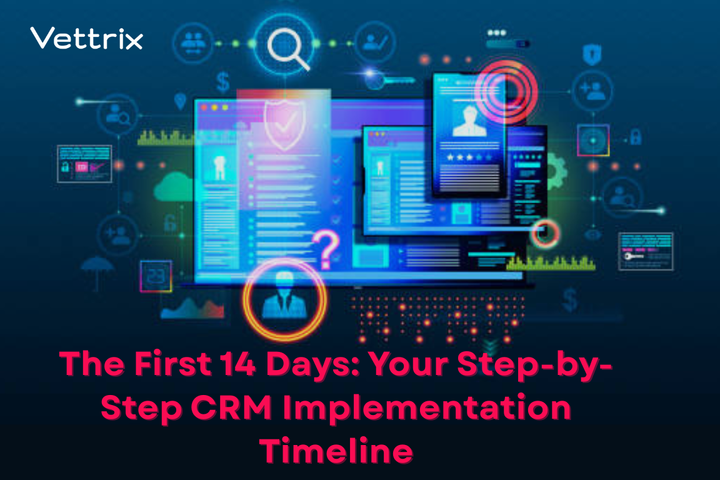The First 14 Days: Your Step-by-Step CRM Implementation Timeline

Implementing a new CRM system is a critical investment that can transform your business operations—but the first two weeks are make-or-break for long-term success. At Vettrix, we've guided hundreds of organizations through successful implementations, and we've found that what happens in the first 14 days largely determines whether your CRM becomes a powerful business asset or an expensive, underutilized tool.
This comprehensive guide provides a day-by-day roadmap for the crucial first two weeks of your CRM implementation. By following this timeline, you'll establish the foundation for high adoption rates, clean data practices, and ultimately, significant ROI from your CRM investment.
Pre-Implementation: Setting the Stage for Success
Before Day 1 officially begins, ensure you've completed these critical prerequisites:
- Defined clear business objectives for your CRM implementation
- Secured executive sponsorship and identified key stakeholders
- Selected your implementation team, including project manager, IT representative, and departmental champions
- Documented current workflows that will be migrated to the CRM
- Established baseline metrics to measure implementation success
The most successful CRM implementations begin with absolute clarity on what success looks like. Your Day 1 should establish not just what you're doing, but why it matters to the business.
Day 1–2: Kickoff & Goal Alignment
Every successful CRM rollout begins with clarity.
Goals:
- Define key CRM objectives (e.g., increase lead conversion, automate follow-ups, improve field sales visibility)
- Identify internal stakeholders (Sales, Marketing, Ops, Field Teams)
- Map out your current sales process
Key Activities:
- CRM kickoff meeting with Vettrix support
- Assign internal CRM champion(s)
- List required customizations and data sources
Day 3–4: Customize Modules & Layouts
Vettrix is built to adapt to your workflow — not the other way around.
Goals:
- Configure modules: Leads, Deals, Activities, etc.
- Add custom fields like “Lead Source,” “Stage,” or “Follow-Up Checkboxes”
- Set up role-based access for teams
Key Activities:
- Edit layouts to match your funnel stages
- Add automation triggers for form inputs
- Define data visibility by user role
Day 5–6: Migrate & Clean Your Data
Messy data kills productivity. These two days are all about importing clean, usable lead and deal records.
Goals:
- Import leads, contacts, and historical data
- Eliminate duplicates and bad formatting
- Categorize leads using tags or filters
Key Activities:
- Use Vettrix’s deduplication and field mapping tools
- Validate emails during migration
- Tag leads by quality (Hot, Cold, Unresponsive)
Day 7–8: Set Up Follow-Up Automation
This is where Vettrix really shines — replacing spreadsheets and reminders with smart automation.
Goals:
- Automate follow-up emails using checkbox triggers
- Sync with Google Sheets to avoid duplicates
- Use email validation to protect deliverability
Key Activities:
- Create email templates for each follow-up stage (Follow-Up 1, 2, etc.)
- Add checkboxes in the lead module to trigger them
- Set up logic to log sent emails in Sheets
Day 9–10: Train Your Sales Team
User adoption is key to CRM success. Training ensures your investment pays off.
Goals:
- Ensure every team member knows how to use the CRM
- Practice using mobile app features for field sales
- Walk through a day-in-the-life of a sales rep
Key Activities:
- Hands-on training sessions (remote or in-person)
- Role-based tutorials: field reps, managers, inside sales
- Real-world simulations: logging a visit, triggering an email, updating lead status
Day 11–12: Build Dashboards & Reports
Sales leaders need real-time visibility. Vettrix dashboards make it easy to monitor team and individual performance.
Goals:
- Visualize KPIs like conversion rate, deal stage velocity, rep activity
- Segment data by region, rep, or lead type
- Set up automated reporting
Key Activities:
- Create and save custom dashboards
- Set filters for tags, stages, and lead sources
- Train managers to access and read live reports
Day 13: Go Live!
Time to turn on the engine and go full throttle.
Goals:
- Launch CRM across teams and channels
- Track activity in real-time
- Ensure follow-ups, notes, and mobile check-ins are working smoothly
Key Activities:
- Test full lead-to-deal process with real leads
- Monitor live email triggers and field entries
- Review initial activity logs for feedback
Day 14: Review, Optimize, Expand
The final day is about reviewing results and fine-tuning the experience.
Goals:
- Collect feedback from your team
- Identify usability issues
- Adjust automation flows or field labels as needed
Key Activities:
- Conduct feedback call with Vettrix support
- Tweak templates, workflows, or layout
- Plan Phase 2: integrations (WhatsApp, Zoom, QuickBooks, etc.)
Final Thoughts: Day 15 and Beyond
You’re live. Your team is trained. Your automation is flowing.
What’s next?
- Connect WhatsApp, Acefone dialer, or Zoom
- Launch drip campaigns or lead scoring
- Expand to support, operations, or partner teams
Your CRM is no longer a database — it’s a sales engine.
Ready to Start Your 14-Day CRM Launch?
The best time to fix your sales process was yesterday.
The second-best time? Today.
🎯 Book your CRM onboarding session
📞 Or talk to our setup experts at sales@vettrix.com